In this guide, we’ll walk you through the most common pizza box sizes and help you make an informed decision for your business.
✅ 14-Inch Pizza Box is the Most Popular – Ideal for medium-sized pizzas, serving small families or couples, and balancing portion size with cost-effectiveness.
✅ Match Box Size to Your Menu – Choose 12-inch or 14-inch for standard pizzas, and 16-inch or 18-inch for larger, party-sized options.
✅ Storage & Delivery Efficiency – Opt for sizes that fit your kitchen space and ensure easy stacking and transport.
✅ Branding & Customization Matter – Custom pizza boxes with logos help reinforce your brand and create a memorable customer experience.
✅ Eco-Friendly Options Available – Sustainable, recyclable packaging helps reduce environmental impact while keeping pizzas fresh.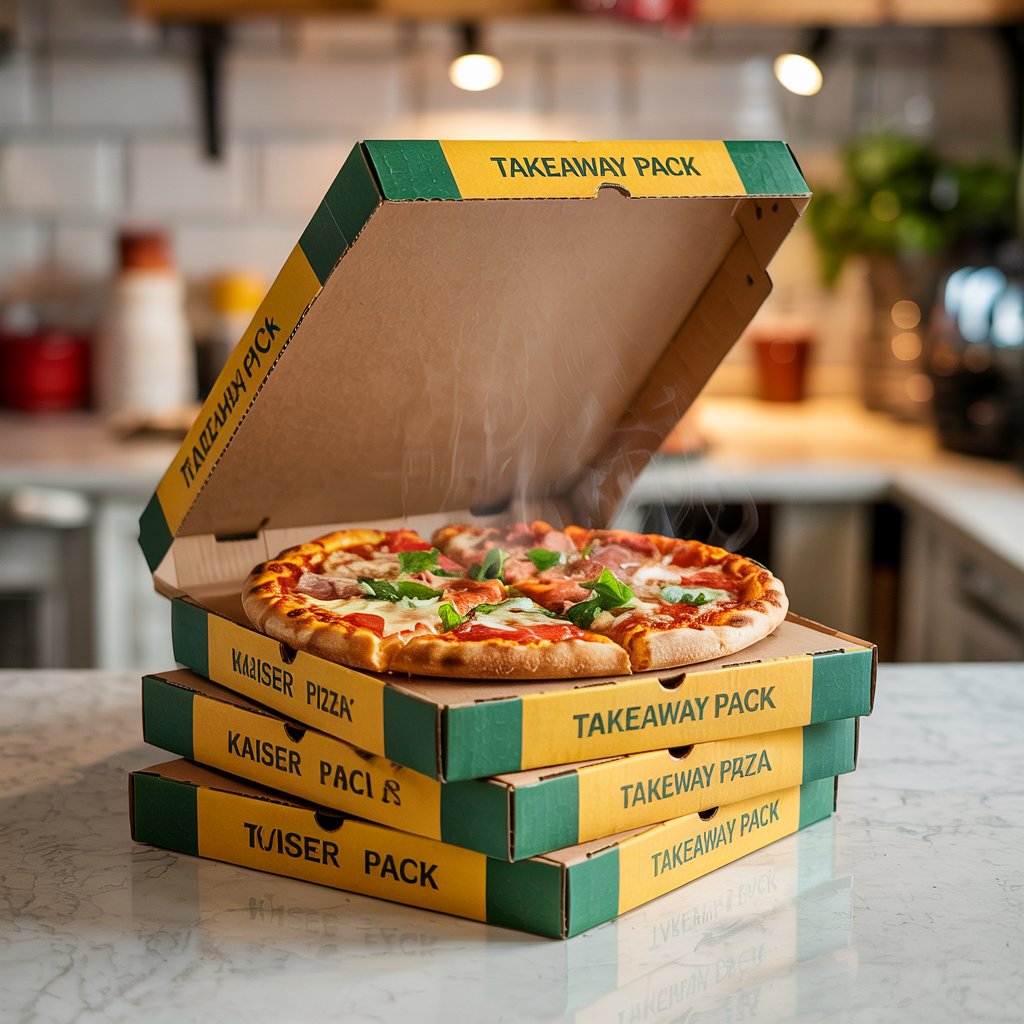
What Is the Standard Pizza Box Size?
Choosing the right pizza box size ensures that your pizzas remain fresh and intact during delivery or takeaway. Here’s a breakdown of standard pizza sizes and their corresponding box dimensions:
Pizza Box Size Chart (A visual representation of pizza sizes and matching box dimensions would be ideal here.)
Using the correct box size ensures a snug fit, which helps maintain temperature, freshness, and presentation quality.
| 10-inch Pizza | 10″ L x 10″ W x 2″ H | This size is ideal for individual servings or smaller personal pizzas. |
| 12-inch Pizza | 12″ L x 12″ W x 2″ H | This is one of the most common sizes for medium pizzas, making it a popular choice for many restaurants. |
| 14-inch Pizza | 14″ L x 14″ W x 2″ H | The 14-inch pizza is often seen as the best balance between portion size and practicality for both customers and businesses. |
| 16-inch Pizza | 16″ L x 16″ W x 2″ H | Large pizzas, perfect for group orders or sharing, fit into this box size. |
| 18-inch Pizza | 18″ L x 18″ W x 2″ H | For extra-large pizzas, typically seen in pizza chains or for party-sized servings, the 18-inch box is commonly used. |
What Is the Most Popular Pizza Box Size?
You may be wondering: What is the most commonly used pizza box size? While this depends on customer preferences and menu offerings, the 12-inch and 14-inch pizza boxes are the most popular choices in the industry.
Among them, the 14-inch pizza box stands out as the top seller. Why? Because it strikes the perfect balance—it’s large enough to serve a small group but compact enough for easy handling and delivery. Additionally, it provides pricing flexibility, making it a go-to option for many restaurants.
Why Is the 14-Inch Pizza Box the Best Choice?
The 14-inch pizza box is widely favored for several reasons:
- Perfect for Medium-Sized Pizzas – It fits a medium pizza, the most commonly ordered size.
- Ideal Portion Size – A 14-inch pizza is great for small families or couples, offering enough food without waste.
- Versatile for Different Pizzas – Whether it’s classic cheese, pepperoni, or specialty toppings, this size accommodates various pizza types.
- Cost-Effective – It provides a balance between portion size and affordability, making it a smart choice for most pizzerias.
- Convenient for Storage & Delivery – The box size makes stacking, storing, and delivering pizzas much easier.
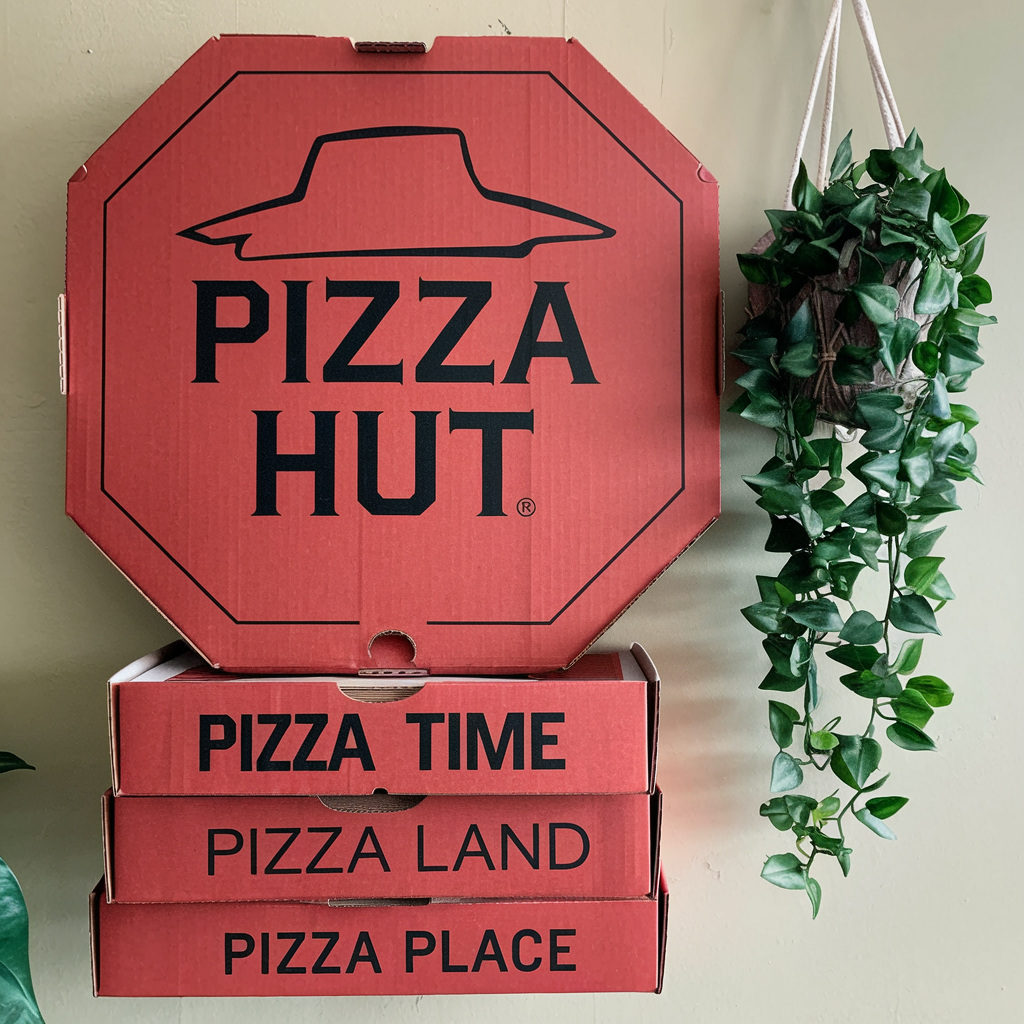
How to Choose the Right Pizza Box Size for Your Restaurant
When selecting pizza box sizes, consider the following factors:
- Know Your Menu – If you primarily offer small or medium pizzas, a 12-inch or 14-inch box is a great fit. For party-sized options, stock 16-inch and 18-inch boxes.
- Understand Your Customers – Do your customers prefer larger pizzas for sharing, or do they lean toward individual-sized portions?
- Consider Storage Space – Larger boxes take up more storage, so choose sizes that align with your restaurant’s space constraints.
- Customization Options – Branded pizza boxes help your business stand out. Takeaway Pack offers customized pizza boxes with logos and eco-friendly materials to enhance your brand image.
Why Choose Takeaway Pack for Your Pizza Boxes?
At Takeaway Pack, we specialize in high-quality, durable pizza boxes designed for both protection and branding. Here’s why we’re the ideal supplier for your restaurant:
 Custom Branding – We create custom pizza boxes with your logo and unique designs to reinforce your brand identity.
Custom Branding – We create custom pizza boxes with your logo and unique designs to reinforce your brand identity.
 Wide Range of Sizes – Whether you need small, medium, or large pizza boxes, we offer various options to match your menu.
Wide Range of Sizes – Whether you need small, medium, or large pizza boxes, we offer various options to match your menu.
 Durable & Reliable – Our sturdy materials ensure pizzas stay intact during delivery, preventing moisture and heat loss.
Durable & Reliable – Our sturdy materials ensure pizzas stay intact during delivery, preventing moisture and heat loss.
 Eco-Friendly Solutions – Sustainability matters. We provide recyclable and eco-friendly packaging to help reduce environmental impact.
Eco-Friendly Solutions – Sustainability matters. We provide recyclable and eco-friendly packaging to help reduce environmental impact.
Conclusion
The 14-inch pizza box is the most popular choice due to its versatility, affordability, and convenience. However, selecting the right size ultimately depends on your menu, customer preferences, and storage capacity.
At Takeaway Pack, we offer premium custom pizza boxes to meet your business needs. Whether you need branding, eco-friendly options, or a variety of sizes, we’re here to help.
Ready to enhance your pizza packaging? Explore our collection today and start customizing your perfect pizza boxes!
]]>In this article:
- Eco-friendliness goes beyond just materials
- What truly makes packaging sustainable?
- Innovation and practicality in sustainable packaging
- Final thoughtsSustainability Is More Than Just Materials
The conversation around sustainable packaging often revolves around materials, but true sustainability extends beyond just what packaging is made of. While compostable, biodegradable, and recycled materials play an important role, factors like reusability, supply chain impact, and overall lifecycle assessment are just as crucial.
For instance, a package designed for multiple uses can significantly reduce waste and resource consumption. A durable, reusable box provides different sustainability benefits compared to single-use biodegradable packaging. In some cases, investing in reusable solutions can have a greater environmental impact than focusing solely on cutting-edge materials.
What Truly Makes Packaging Sustainable?
Eco-friendly packaging can be defined as packaging that minimizes environmental harm throughout its lifecycle. This includes:
- Renewable & Recyclable Materials: Packaging made from resources that can be replenished or easily recycled.
- Reduced Carbon Footprint: The energy and emissions involved in the production, transportation, and disposal of packaging matter.
- Reusability & Circular Economy: Packaging designed for multiple uses keeps materials in circulation longer, reducing the need for new raw materials.
- Biodegradability & Compostability: Materials that break down naturally without leaving toxic residues are ideal for a zero-waste future.
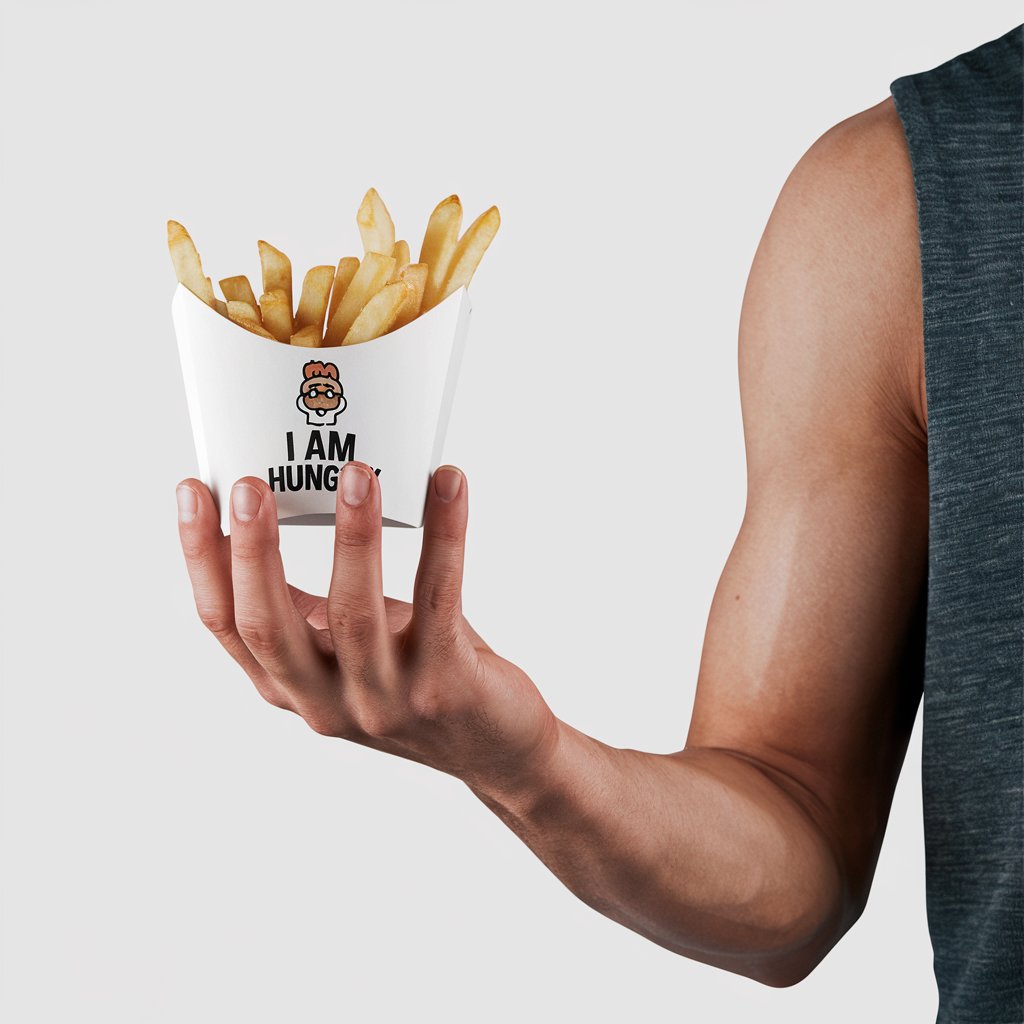
Innovation and Practicality in Sustainable Packaging
While advanced materials like hemp, mushroom-based, and seaweed packaging are gaining traction, they are not always practical or accessible for all businesses. Sustainable packaging doesn’t have to be a radical reinvention—it can be as simple as making better use of existing solutions.
Some widely available and effective eco-friendly packaging options include:
- Recycled Paper & Cardboard: A staple in sustainable packaging, widely available and easy to recycle.
- Kraft Paper: Strong and biodegradable, made from a broader range of tree sources.
- Compostable Packaging: Made from plant-based materials like cornstarch, sugarcane, and beets, breaking down in months rather than years.
- Recycled & Virgin Paper Pulp: Combining recycled fibers with new fibers ensures durability while maintaining sustainability.
Sustainable Packaging: Small Changes, Big Impact
Many businesses hesitate to adopt sustainable packaging due to cost or availability concerns. However, incorporating even small changes—such as switching to FSC-certified paper products or designing for reusability—can make a significant impact.
Ultimately, sustainability is about balance. While futuristic materials like mycelium and seaweed-based packaging show great promise, more traditional materials like recycled cardboard and kraft paper remain among the most practical, scalable, and cost-effective solutions for businesses today.
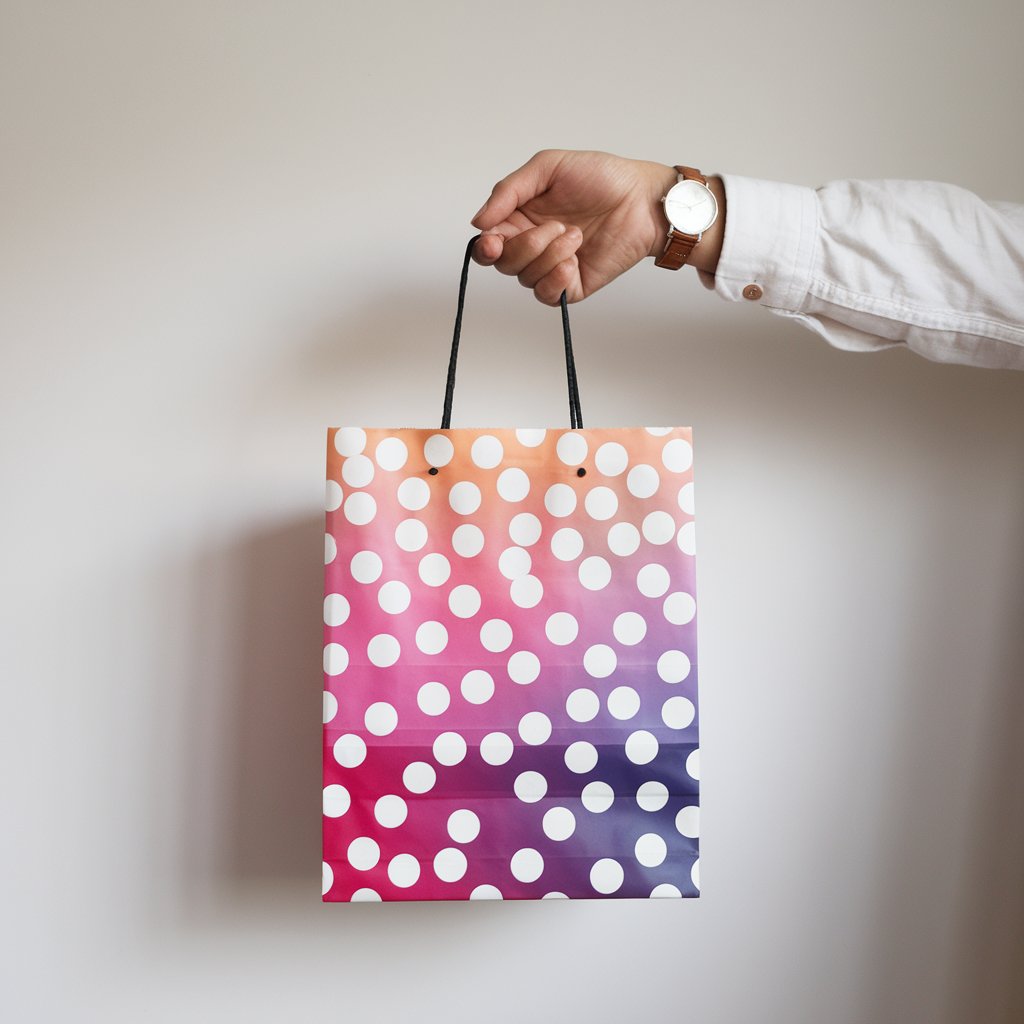
Final Thoughts
Eco-friendly packaging isn’t just about what it’s made of—it’s about how it’s used and where it goes after use. By focusing on materials, reusability, and lifecycle impact, businesses can take meaningful steps toward more sustainable packaging solutions.
At TakeawayPack, we offer a wide range of customizable, sustainable packaging solutions that fit both your brand’s needs and environmental goals. Whether it’s recyclable, biodegradable, or reusable packaging, we make it easy for businesses to go green without compromise.
]]>With the rising demand for healthy eating, salads have become a go-to choice for low-calorie, nutrient-rich meals. This article explores innovative salad shop packaging ideas that not only preserve freshness but also reinforce a brand’s health-conscious and eco-friendly image.
KEY TAKEAWAYS:
✅ See the Freshness – Transparent packaging highlights vibrant ingredients! 🥬🥕
✅ Go Green – Use biodegradable bowls, recycled paper bags & plant-based containers 🌍♻
✅ Minimal & Chic – Simple, natural designs with earthy tones for a clean, organic feel 🎨🛍
✅ Smart Packaging – Compartmentalized containers keep ingredients fresh & crisp! 🥜🥗
✅ Nature-inspired Branding – Leafy patterns & eco-friendly messaging attract health-conscious customers 🍃💚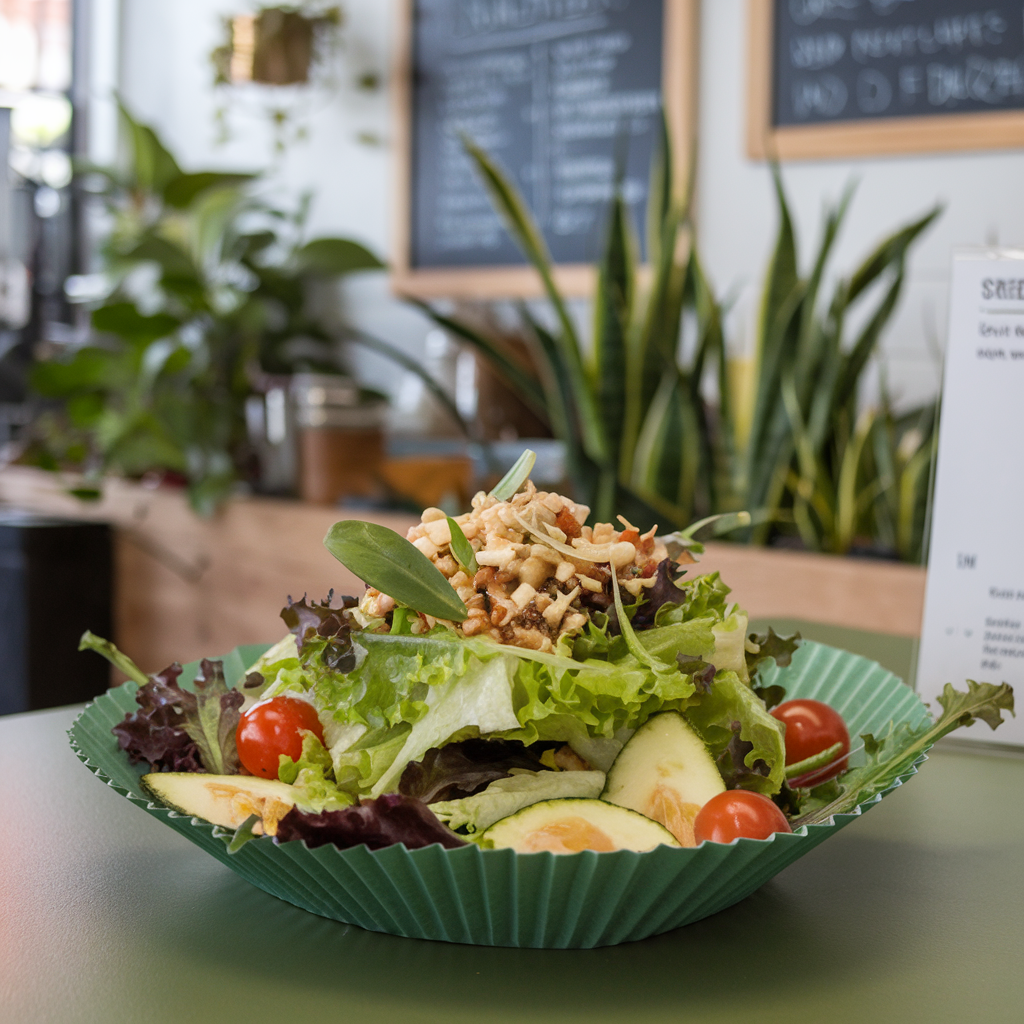
The Growing Popularity of Healthy Salads
Increased Health Awareness
As people become more mindful of their diets, there is a stronger focus on consuming foods that provide essential nutrients while supporting overall wellness. Salads, known for their low-calorie yet fiber-rich, vitamin-packed ingredients, are now a staple in many diets worldwide.
Diverse and Customizable Options
Salads offer immense variety, incorporating fresh vegetables, fruits, nuts, beans, proteins (chicken, beef, fish), and dairy (cheese, yogurt). This flexibility allows consumers to tailor meals to their tastes and dietary preferences.
Convenience for Busy Lifestyles
With hectic schedules, consumers seek quick, healthy meal options. Pre-packaged salads available in supermarkets and restaurants cater to professionals and students who prioritize health but have limited time for meal preparation.
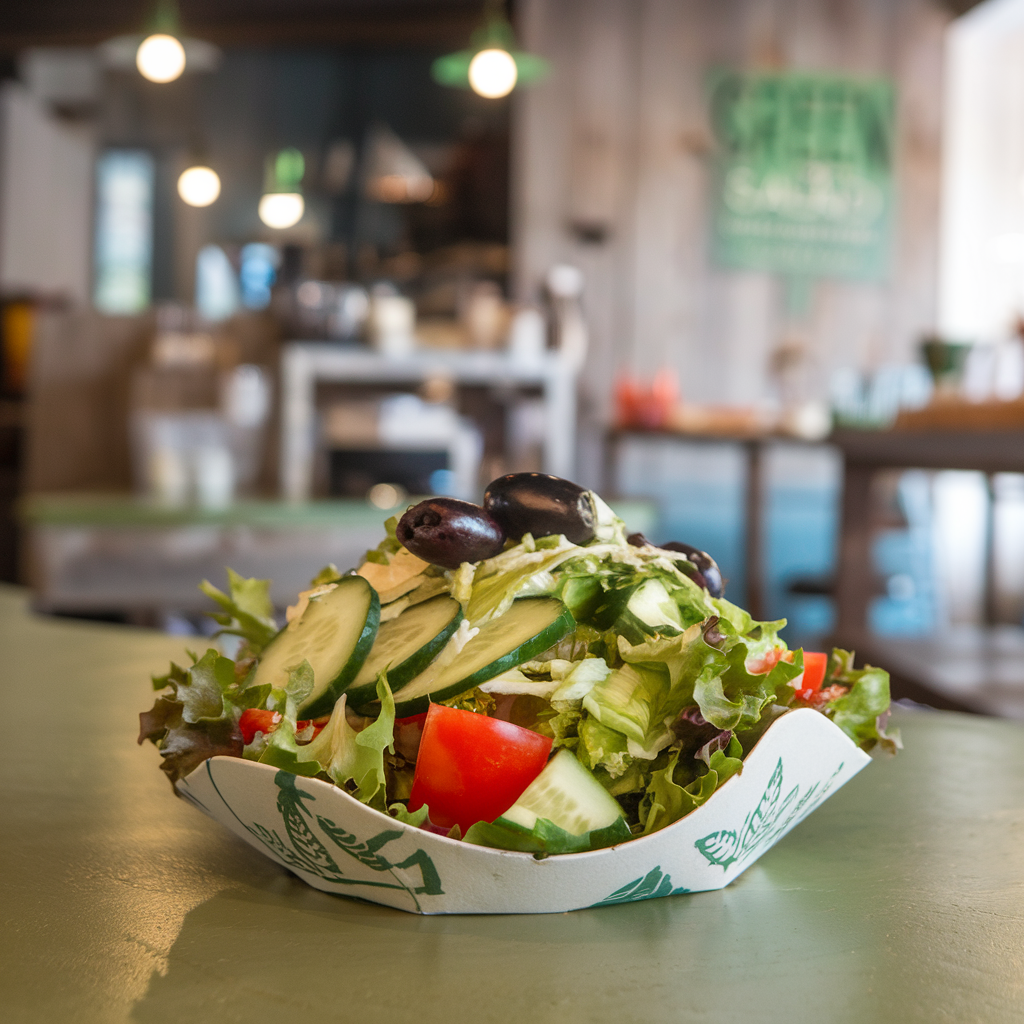
Prioritizing Health and Sustainability in Salad Shop Packaging
To reinforce a salad shop’s commitment to wellness and sustainability, choosing the right packaging is essential. Opting for eco-friendly materials like compostable containers and recyclable packaging not only aligns with environmental values but also enhances a brand’s reputation among health-conscious consumers.
Choosing the Right Salad Shop Packaging Materials
Transparent and Fresh-Preserving Materials
Using clear or semi-transparent packaging allows customers to see the fresh ingredients inside, making the product visually appealing. Clamshell containers, for instance, effectively highlight the vibrant colors of a garden salad, attracting buyers looking for freshness and quality.
Sustainable and Biodegradable Options
Selecting biodegradable or recyclable packaging materials, such as paper or bioplastics, minimizes environmental impact while reinforcing a brand’s sustainability efforts. Compostable salad bowls, recycled paper bags, and plant-based containers provide eco-conscious customers with guilt-free packaging solutions.
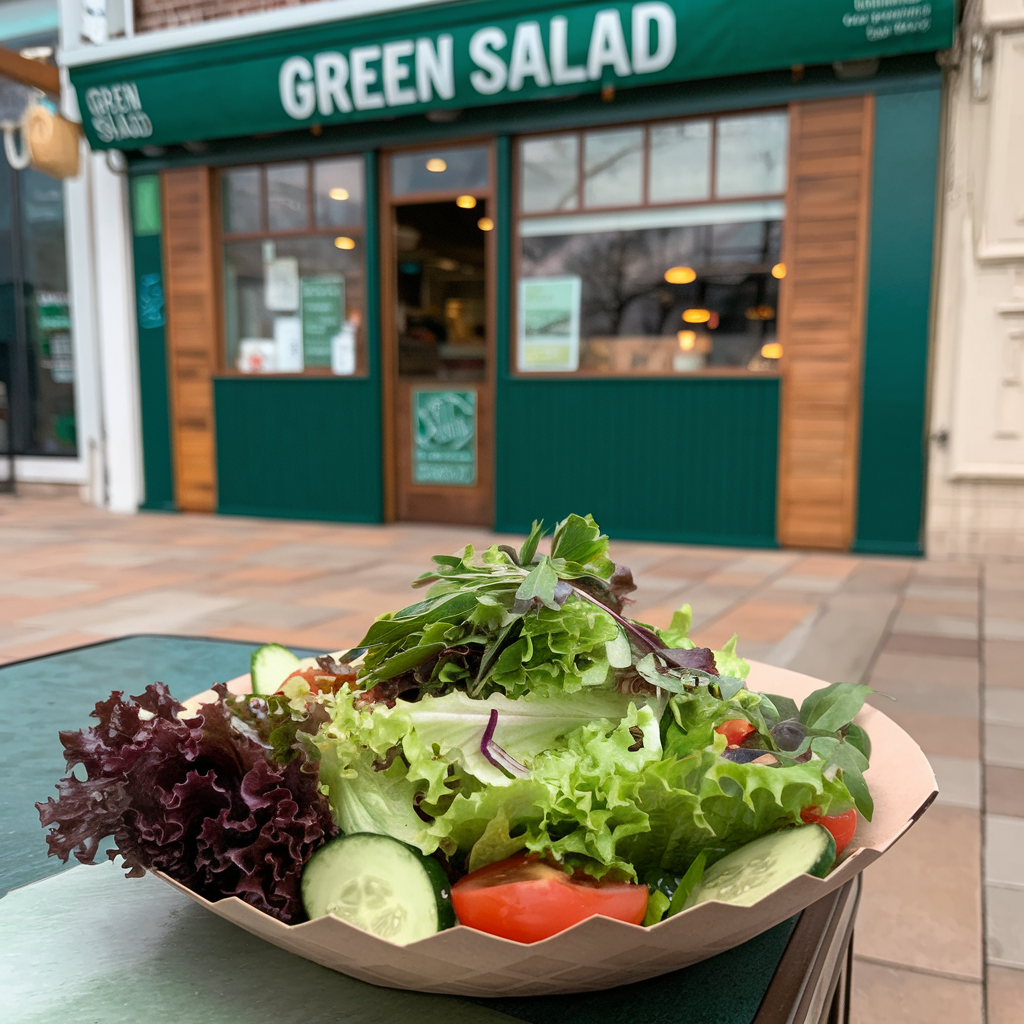
Smart Packaging Design Salad Shop Packaging
Natural Color Schemes
Utilizing earthy tones like green and brown in packaging can evoke a sense of nature, health, and freshness. These colors align with the organic essence of salads and appeal to eco-friendly consumers.
Minimalist and Clean Aesthetic
A simple and elegant design enhances product visibility while reducing clutter. Clear fonts, minimal branding, and a sleek, natural look create a sophisticated yet approachable brand identity. A kraft paper box with a clear window and a subtle logo, for example, effectively conveys a wholesome, natural message.
Functional and Innovative Packaging Structures
Creative packaging structures, such as compartmentalized containers, help keep ingredients fresh until consumption. Separate sections for dressings, nuts, or croutons maintain texture and flavor, ensuring a better customer experience. Innovative divided containers also add convenience for on-the-go consumers.
Nature-inspired Patterns and Branding
Incorporating plant motifs or illustrations of leafy greens on packaging reinforces the freshness and health benefits of salads. Such designs create an emotional connection with health-conscious buyers, making the product stand out on store shelves.
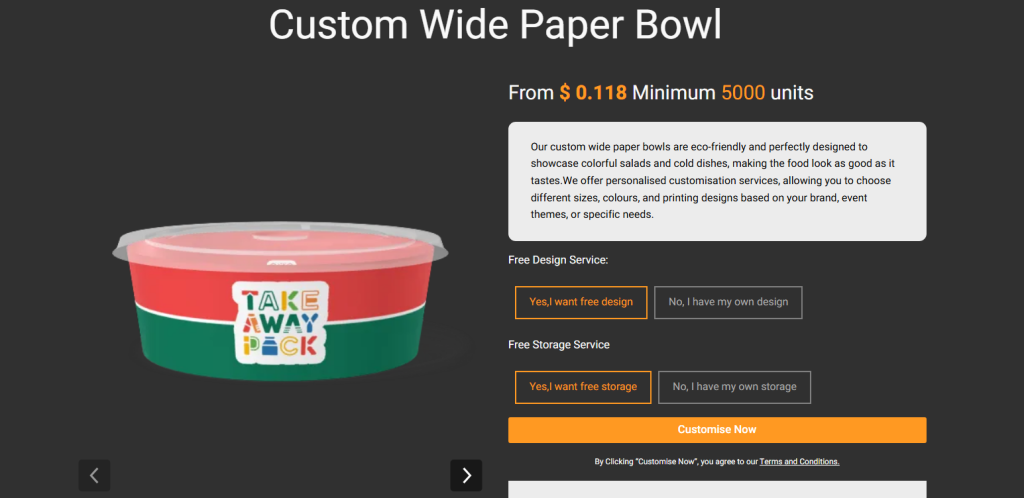
Conclusion
Implementing smart packaging solutions enhances a salad shop’s brand identity by showcasing a commitment to health and sustainability. By focusing on transparency, eco-friendly materials, minimalist design, innovative structures, and nature-inspired aesthetics, salad businesses can attract and retain health-conscious customers.
TakeawayPack specializes in crafting sustainable, visually appealing packaging that aligns with these principles. Let us help you design the perfect packaging to elevate your brand and make your salads stand out in a competitive market.
For more details on how TakeawayPack can support your business, contact us at [email protected].
]]>Worried about how to keep your fried chicken crispy or dealing with packaging challenges?
Our Fried Chicken Restaurant Packaging Guide is here to address your concerns. If your food isn’t staying hot or customers are facing packaging-related issues, don’t worry. This guide will walk you through the best packaging solutions to keep your fried chicken fresh and flavorful while ensuring a positive customer experience.
By the end of this guide, you’ll know how to package fried chicken that stays warm, looks appealing, and boosts your brand. Let’s dive in!
KEY TAKEAWAYS:
🍗 Keep Your Fried Chicken Hot & Crispy! 🔥
Struggling with soggy chicken or packaging that doesn’t hold up? 😩 Our Fried Chicken Restaurant Packaging Guide has got you covered! ✅
📦 Best Packaging Options: Cardboard boxes, foil containers, and more!
🔥 Heat Retention Tips: Keep food fresh and crispy every time!
🎨 Branding Boost: Custom packaging = more customer love! 💕
🌱 Eco-Friendly Choices: Go green with sustainable packaging!
Make sure your chicken arrives hot, crispy, and delicious—just the way customers love it! 😍🍟 Read the full guide now! 🚀
Why Packaging Matters for Fried Chicken
Packaging is essential to maintaining the quality and presentation of fried chicken. The right packaging ensures your chicken remains crispy, hot, and moisture-free, preventing sogginess and preserving that crispy texture. This is particularly important for takeout and delivery, where food may be transported for an extended period. Without proper packaging, fried chicken can lose its crispiness and appeal.
Additionally, packaging serves as a branding tool. Custom-designed packaging with your restaurant’s logo and color scheme can make your establishment memorable and keep customers coming back for more. Good packaging doesn’t just protect the food—it reinforces your brand and enhances the customer experience.
Types of Packaging for Fried Chicken
Here are several packaging options, each with its pros and cons. Choosing the right one will depend on your restaurant’s needs and goals.
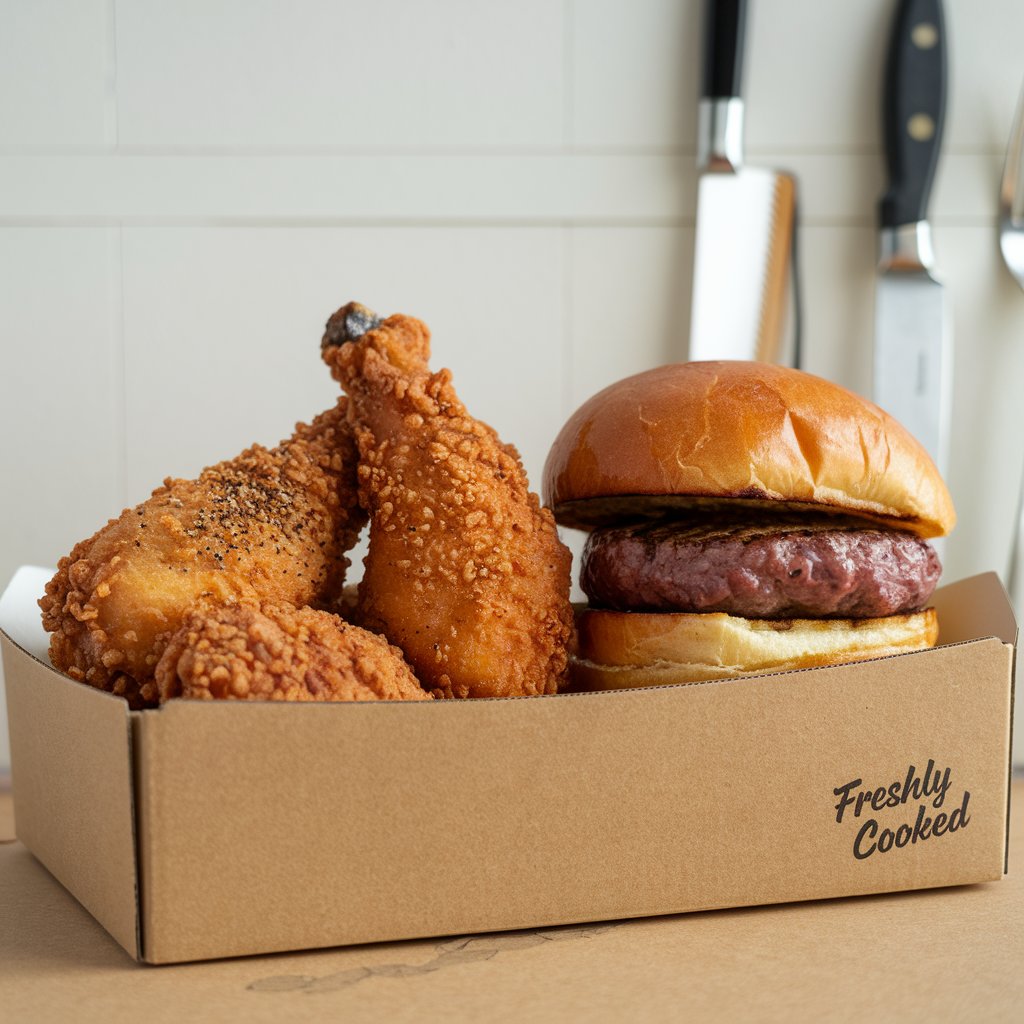
Cardboard Boxes
Cardboard boxes are one of the most popular choices for packaging fried chicken. They’re sturdy, customizable, and environmentally friendly. These boxes work well for keeping food warm and are perfect for serving fried chicken in a variety of portion sizes. However, without proper lining, they can become soggy, making them less effective for longer deliveries.
- Pros:
- Keeps food warm
- Customizable for branding
- Eco-friendly and recyclable
- Durable for various portion sizes
- Cons:
- Can become soggy if not lined properly
- Less effective for long-distance delivery
- Bulky and takes up space
- Doesn’t retain crispiness as well as other options
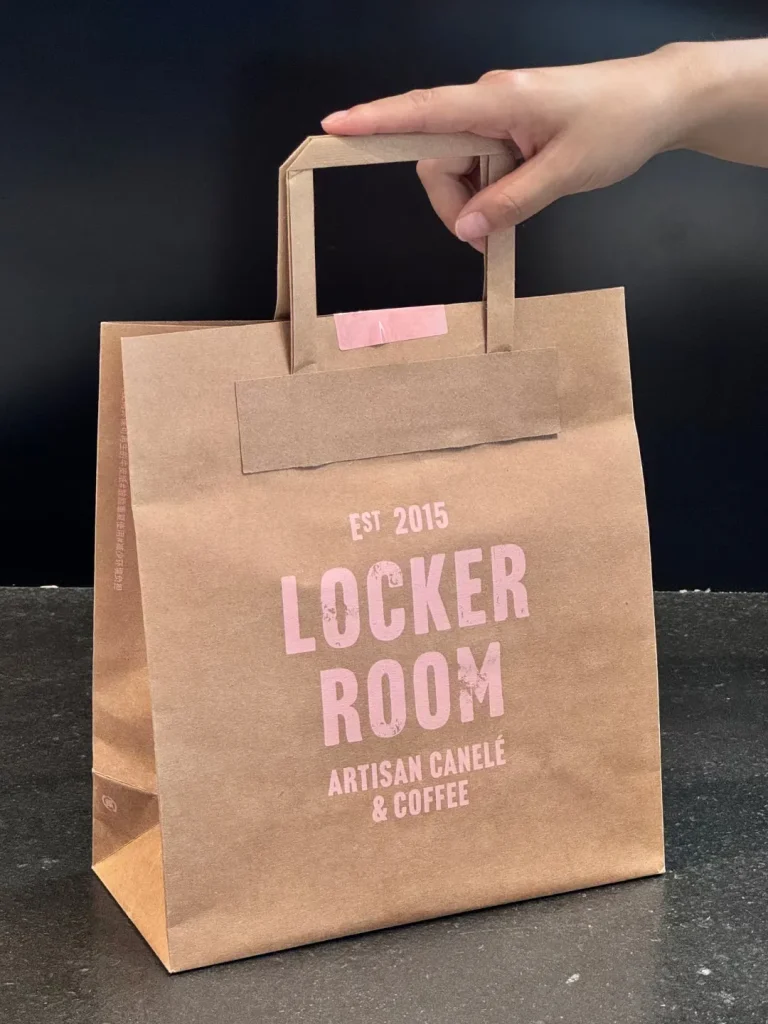
Paper Bags
Paper bags are light, cost-effective, and biodegradable, making them a popular option for casual dining or smaller orders. While they are easily customizable, they don’t do much to keep the food hot or crispy, especially for long deliveries.
- Pros:
- Lightweight and inexpensive
- Customizable with prints
- Biodegradable and recyclable
- Easy to handle
- Cons:
- Poor heat retention
- Not durable enough for heavier items
- Prone to tearing
- Less effective at maintaining crispiness
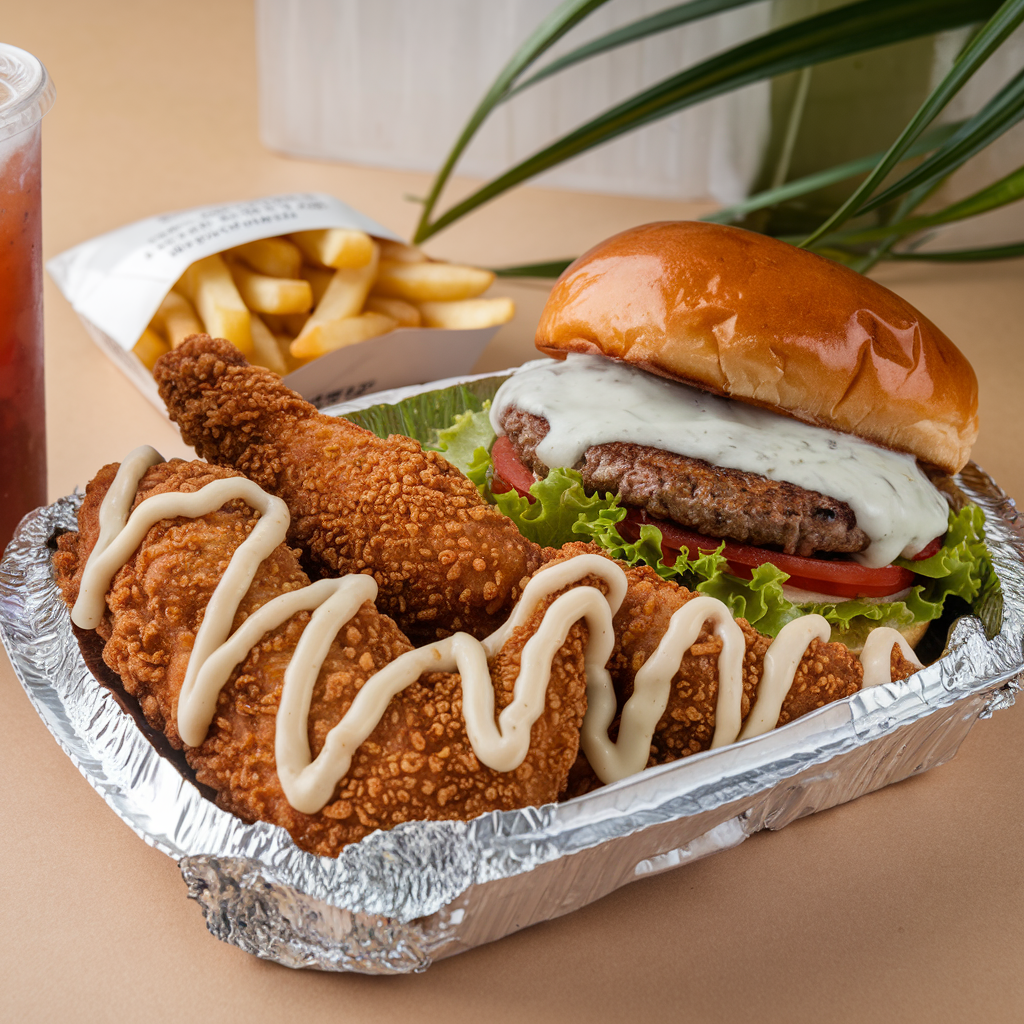
Foil Containers
Foil containers are another great option for keeping fried chicken crispy. They are highly effective at maintaining temperature and moisture, which is perfect for takeout. However, they are less customizable, prone to dents, and not as durable as other options.
- Pros:
- Great heat retention
- Keeps food crispy
- Seals tightly to prevent leaks
- Good for both single and large orders
- Cons:
- Limited customization options
- Easily dented or bent
- Not as eco-friendly
- Less durable for heavy items
Key Points for Effective Packaging
When designing packaging for your fried chicken, there are several factors to keep in mind to ensure that it meets your business’s needs:
Heat Retention:
Choose packaging that retains heat without trapping moisture. This will help maintain the crispy texture of your fried chicken, which is crucial for customer satisfaction.
Portion Sizes:
Packaging should be appropriately sized for the portions you serve. This reduces waste and ensures that customers get exactly what they expect. Oversized packaging can lead to unnecessary costs, while undersized packaging can lead to spills or an unappealing presentation.
Branding and Design:
Your packaging is an extension of your restaurant’s brand. Custom-designed packaging with your logo, color scheme, and restaurant theme makes a lasting impression. It can even act as a marketing tool by reminding customers of your brand every time they use it.
Sustainability:
Today’s customers are increasingly eco-conscious. Consider using recyclable or biodegradable packaging materials to appeal to this growing demographic. It shows that you care about the environment, which can help build trust with your customer base.
Convenience Features:
Look for packaging options that offer extra features such as compartments for sauces, easy-to-open designs, and spill-proof seals. These thoughtful touches can elevate the customer experience and make them more likely to return.
Tips for Success
To ensure the effectiveness of your packaging strategy, here are some additional tips:
Test Your Packaging:
Before making a large-scale investment in packaging, test different options. Gather feedback from staff and customers to determine which packaging works best for your needs.
Stay Current:
Keep an eye on packaging trends and innovations. As packaging technology evolves, new options may offer better functionality or eco-friendliness.
Train Your Staff:
Proper training is essential to ensure that your staff knows how to package food correctly. Consistency in packaging is key to delivering a consistent customer experience.
Monitor and Adjust:
Continually assess the performance of your packaging. If customers report issues or if the packaging isn’t meeting your expectations, don’t hesitate to make adjustments.
Conclusion
Effective packaging is the backbone of any fried chicken restaurant. It ensures that your food stays fresh, maintains your brand identity, and enhances the customer experience. By following this guide, you can select the right packaging that keeps your fried chicken hot, crispy, and ready to impress your customers. Whether you’re serving up a casual meal or packaging for delivery, the right packaging will make all the difference in the satisfaction of your customers and the success of your business.
]]>